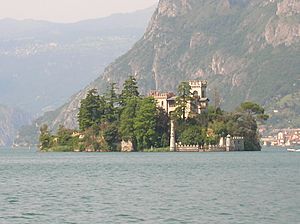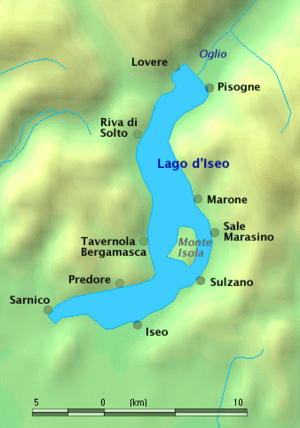Lake Iseo facts for kids
Quick facts for kids Lake IseoLago d'Iseo |
|
|---|---|

Isola di Loreto
|
|

map
|
|
| Location | Lombardy |
| Coordinates | 45°43′N 10°05′E / 45.717°N 10.083°E |
| Primary inflows | Oglio |
| Primary outflows | Oglio |
| Catchment area | 1777 km² |
| Basin countries | Italy |
| Max. length | 25 km |
| Surface area | 65.3 km² |
| Average depth | 124 m |
| Max. depth | 251 m |
| Residence time | 4.2 years |
| Surface elevation | 181 m |
| Islands | Monte Isola, Loreto, St. Paul |
Lake Iseo, also known as Lago d'Iseo or Sebino, is a beautiful lake in the Lombardy region of Italy. It is the fourth largest lake in Lombardy and a popular spot for both locals and tourists. The Oglio river flows into the lake and also flows out of it, keeping the water fresh. Lake Iseo is surrounded by green mountains and charming towns, making it a wonderful place to explore.
Contents
Welcome to Lake Iseo!
Lake Iseo is a long, narrow lake located in northern Italy, nestled between the Province of Brescia and the Province of Bergamo. It's part of the Italian subalpine lakes, which were carved out by ancient glaciers. The lake is about 25 kilometers (15.5 miles) long and covers an area of 65.3 square kilometers (25.2 square miles). Its deepest point is 251 meters (823 feet), which is quite deep! The lake sits at an elevation of 181 meters (594 feet) above sea level.
How Was Lake Iseo Formed?
Like many other large lakes in northern Italy, Lake Iseo was formed thousands of years ago by huge sheets of ice called glaciers. As these glaciers slowly moved down from the mountains, they carved out deep valleys. When the climate warmed, the glaciers melted, and their meltwater filled these valleys, creating the lakes we see today, including Lake Iseo. This process left behind the unique shape of the lake and the surrounding hills.
Exploring the Islands
Lake Iseo is famous for its islands, especially Monte Isola, which is the largest lake island in Italy and one of the largest in Europe. There are also two smaller islands, Loreto and St. Paul.
Monte Isola: Europe's Largest Lake Island
Monte Isola means "Mountain Island," and it truly is a small mountain rising from the lake. It's home to several small villages where people live and work. You can reach Monte Isola by ferry from various towns around the lake. Once there, you can explore the island by walking, cycling, or using the local bus. Cars are mostly not allowed, which makes it a peaceful place. The island is known for its traditional fishing villages, olive groves, and beautiful views. At the very top of the island, there's a small sanctuary called the Madonna della Ceriola, offering amazing panoramic views of the lake and mountains.
Loreto and St. Paul Islands
The other two islands, Loreto and St. Paul, are much smaller and privately owned. Loreto Island has a beautiful castle and a small harbor. St. Paul Island, also known as Isola di San Paolo, has a monastery that was once home to monks. These islands add to the picturesque scenery of Lake Iseo.
Plants and Animals of Lake Iseo
Lake Iseo is a home for many different kinds of plants and animals. The clear waters support various fish species, including Pike, Perch, Trout, and Chub. Fishing has been an important activity for the people living around the lake for centuries.
Around the shores and in the surrounding hills, you can find typical Mediterranean vegetation. This includes olive trees, which are very important for the local economy as they produce delicious olive oil. There are also many types of trees and shrubs that thrive in the mild climate. Birdwatchers might spot various water birds, like ducks and gulls, and even some herons along the quieter parts of the shore. The lake and its surroundings are part of a biosphere reserve, which means efforts are made to protect its natural environment.
Fun Things to Do at Lake Iseo
Lake Iseo offers many fun activities for visitors.
- Boating and Water Sports: You can rent boats, kayaks, or paddleboards to explore the lake. Swimming is also popular in designated areas during the warmer months.
- Cycling and Hiking: There are many trails around the lake and in the surrounding mountains. You can cycle along the lake's edge or hike up to viewpoints for stunning scenery.
- Exploring Towns: Charming towns like Iseo, Sarnico, Lovere, and Pisogne are located on the lake's shores. They have old churches, interesting shops, and lovely waterfront promenades.
- Local Food: Don't forget to try the local food! The area is known for its fresh fish from the lake, olive oil, and delicious wines.
A Famous Art Project: The Floating Piers
In 2016, Lake Iseo became famous worldwide for an amazing art project called "The Floating Piers." This project was created by the artist Christo. He built a temporary walkway made of bright yellow fabric that floated on top of the water. People could walk across the lake from the town of Sulzano to Monte Isola and even to the small island of San Paolo. Millions of people came from all over the world to experience walking on water, making it a truly unique and memorable event for Lake Iseo.
Protecting Lake Iseo
Protecting the natural beauty and health of Lake Iseo is very important. The lake is part of a biosphere reserve, which means there are special plans to help people live and work in harmony with nature. This includes managing tourism, protecting water quality, and preserving the local plants and animals. Efforts are made to keep the lake clean and beautiful for future generations to enjoy.
Images for kids
See also
 In Spanish: Lago Iseo para niños
In Spanish: Lago Iseo para niños


